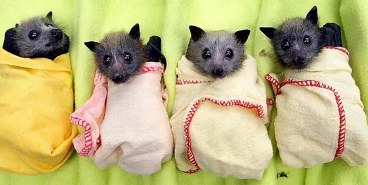The president of the wildlife rehabilitation centre northwest of Cochrane is going batty.
Clio Smeeton’s Cochrane Ecological Institute (CEI), hopes their experimental project might break new ground in how wildlife researchers identify bats, and add to the scientific knowledge in the field.
With a hand from local schools and a grant, the CEI is embarking on a collaborative effort involving students and residents willing to put up bat houses on their property.
“We have a lot of individual supporters in the Cochrane area and will have bat sound meters on their properties, both in Cochrane, along the river, and up on the hills to the west. These are participating landowners and wonderful people,” Smeeton said.
The Cochrane Foundation awarded the CEI $5,055 on March 16, during their annual awards announcement at SLS Centre.
Smeeton said recording and identifying bat species using their ecolocation sounds is a very new process, as recording equipment is getting much more precise than it used to be.
“If we can demonstrate this is a reliable and workable method for identifying bat species then, with a bit of luck, it will reduce the reliance on capturing bats through the use of mist nests,” she explained.
Mist nets are useful, but an unavoidable stress creator for capturing bats. Bat species populations are hard to monitor and are under threat worldwide, so this is an important project.
The study findings will be shared with other organizations, on a local, provincial, and national level. An M.Sc. candidate from the University of Dublin, Ireland, will be working on the project as well.
In addition to the research aspect of the work, Smeeton said the CEI will be providing bat conservation education to youth in schools and community groups in Cochrane, both in the classroom and in the field.
Class presentations will take students into the wide world of bats, dispel myths, and explore these animals’ vital role in the environment.
The interactive program will conduct water studies and macroinvertebrate analysis, allowing the CEI to understand the best habitat for bats.
St. Timothy Junior-Senior High School teachers will build six colony sized bat boxes as part of their years’ Service Project, while the Town of Cochrane, with the help of parks and open spaces manager Trish Klune, will help install the boxes in pre-determined locations.
There nine bat species in Alberta.
Bat facts that will be dispelled through the CEI’s advocacy include that they’re shy of humans and won’t fly into you; they are not blind, and can see in daylight or night; they use ecolocation to fly and feed; they can have rabies, so humans should not handle them; they are usually found around trees or water.; they hibernate or migrate for the winter; they sleep, mate and have babies upside down; and they have been around for more than 2.5 million years.
Threats to bats include wind turbines, forest over-harvesting, climate change, light pollution, noise pollution, and white noise syndrome, which is a fungal disease that wakes bats up and spreads during hibernation, causing dehydration, starvation, and death. The Alberta Community Bat Program has reports white noise syndrome has been cited as being responsible for the loss of six million bats in North America, and has recently been found in Alberta.
Bats contribute to the health of the environment, consume insects that harm livestock, crops, and produce and help control spread of diseases like West Nile virus. One bat can eat 1,000 mosquitoes in an hour.
The CEI’s classroom presentation recommends some ways to help bats, such as turning off unnecessary lights at night, promoting habitat at home, minimizing use of pesticides, providing shelter with a bat box, avoiding the disturbance of bats in their homes, and removing unwanted bats humanely.
The research will employ four sound bat meters to determine which species are present, their population numbers, favored habitat, active times, and whether they migrate or hibernate. This information will be shared with Wildlife Acoustics (the manufacturer), the Alberta Community Bat Program, and the Canadian Bat Box Study. Trail cameras on site at the CEI may be able to capture bats at night as well as other nocturnal wildlife activity.
Bat box materials and instructions for construction are being provided to St. Timothy School, where students have volunteered to build boxes.
Manachaban Middle School will be involved in the education program, and École Notre Dame des Vallés and Holy Spirit School are participating as well.
The CEI is funded through charitable donations and the occasional grant – there is no provincial funding. All the income from the attached Happy Tails pet kennels goes towards running the rehabilitation centre.
For more information on the work of the CEI, go to ceiwildlife.org.



